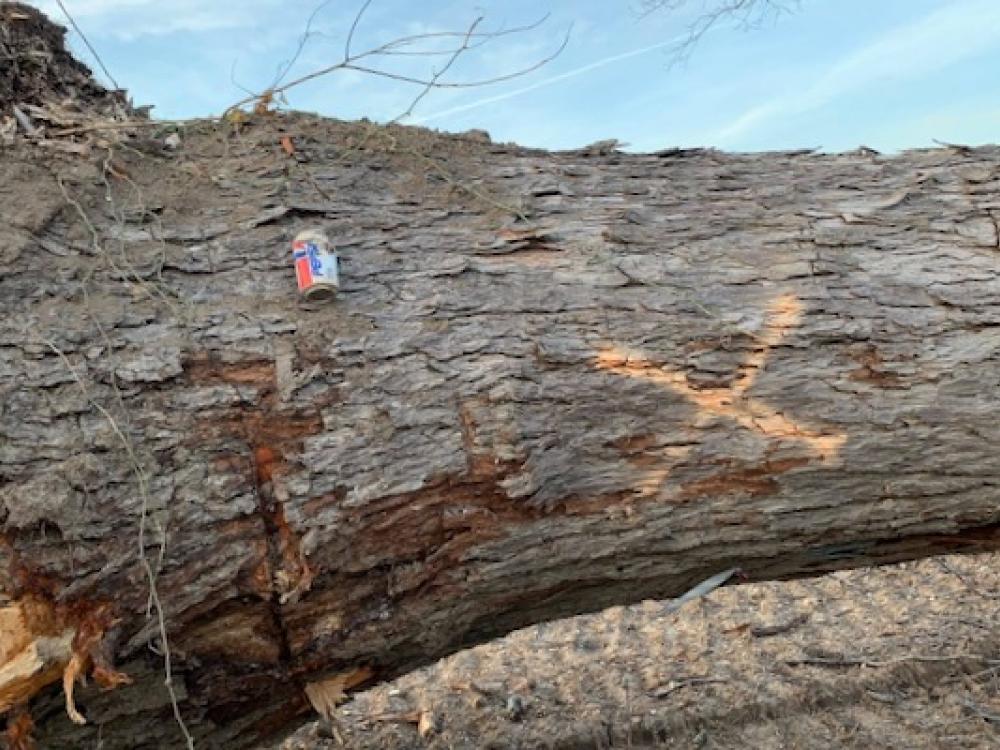
Don Young was dismayed to discover a grove of large trees bulldozed to make way for apartments in west Fort Worth last month. Photo by Don Young.
April 1, 2021
By now, it’s happened to every tree lover.
You drive by a wooded lot on your route or admire a stand of trees outside an office window. You might even mistake it for a park.
And then one day you look and it's gone.
Bulldozers are pushing trunks into a pile. Some shell-shocked survivors dot the landscape.
And you blurt out:
“Don’t we have a tree ordinance?”
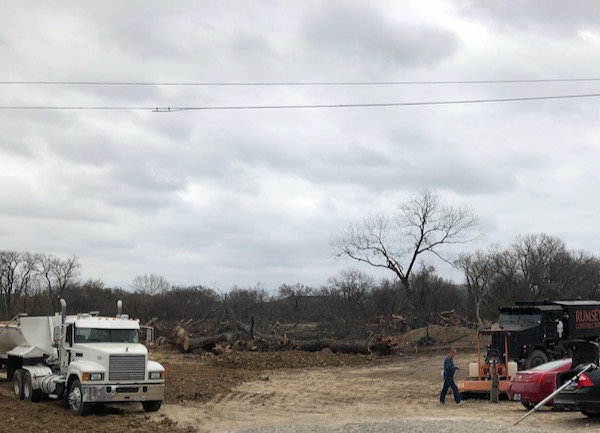 Workers clear out a stand of large trees to make way for development in west Fort Worth, near 4000 Bryant Irvin. Photo by Julie Thibodeaux.
Workers clear out a stand of large trees to make way for development in west Fort Worth, near 4000 Bryant Irvin. Photo by Julie Thibodeaux.
Recently, Don and Debora Young went to a favorite shady spot along the Clear Fork of the Trinity River in west Fort Worth, behind Whole Foods. They expected to see a familiar stand of towering trees. Instead they found a circle of stumps. The couple — long-time conservationists and cofounders of the Friends of Tandy Hills Natural Area — surveyed the site in horror.
“These giants were stacked up like cordwood for about a quarter mile,” Don Young wrote in a Facebook post last month. “They must have been among the oldest trees left in town. I measured one at more than four feet in diameter. Seems to me there should stricter code enforcement for protecting treasures such as this.”
According to Rochelle Joseph, assistant director of Development Services for Fort Worth, the zoning and site plan for the lot was approved in 2014 to make way for construction of the Waterside multi-family development. The developer, Trademark Property, followed the city’s tree ordinance, which requires they preserve only 25 percent of the tree canopy.
They felled around 20 significant trees - legally.
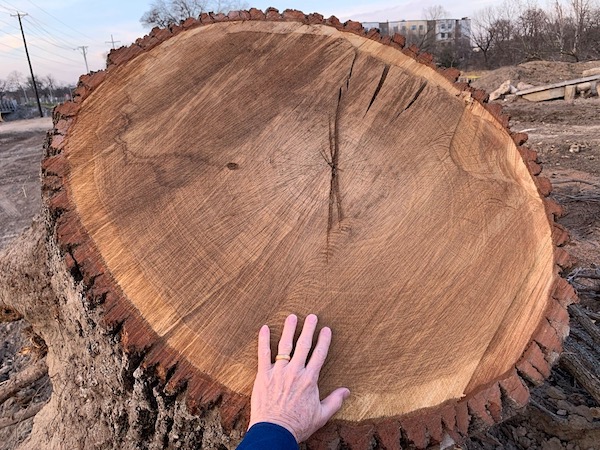 A large tree cut down for Waterside apartments. Photo by Don Young.
A large tree cut down for Waterside apartments. Photo by Don Young.
According to the Fort Worth tree ordinance, which was created in 2007, trees considered significant are typically large trees measuring at 27 inches in diameter or 18 inches for a post oak or blackjack oak.
The city can’t stop a property owner from cutting down healthy, mature trees, only limit their removal by providing incentives for preservation and requiring mitigation for removal.
“Mitigation for the removal of large trees can come in the form of additional preservation (above the 25 percent required), additional planting above what is required or payment into a Tree Fund,” the City's Urban Forestry Review Team responded. “The Tree Fund is used to plant trees on public property or land acquisition for the purpose of tree preservation.”
The Waterside developer in this case chose to preserve 50 percent of the tree canopy, rimming the property, including 10 significant trees. But to the Youngs, they cut the heart out of the grove.
A towering tree felled for development in west Fort Worth, off Bryant Irvin road behind Whole Foods. Video by Don Young.
HISTORIC TREES
Across the Metroplex, Steve Houser, cofounder of the Texas Historic Tree Coalition, has been fighting tree battles for decades in Dallas.
He said the Dallas tree ordinance is one of the best in North Texas. According to Houser, it grew out of a fight in the early 1990s to save some 70 trees on Presbyterian Hospital property.
Dozens of tree lovers joined in the fight, eventually convincing developers to save more than half of the trees. It led to the formation of what is today called the Texas Historic Tree Coalition, a nonprofit which Houser cofounded.
Despite the progress, Houser said when it comes to saving trees, there is still not the political will in Texas to create a stricter tree ordinance.
“Legally it’s very hard for any city to tell a property owner you can’t cut [trees] down. That was a hard cruel fact of life to learn,” he said.
He believes the best defense for trees is a good offense. That's why he's worked to recognize individual trees before developers have their axes out.
The central mission of the Texas Historic Tree Coalition is to identify significant trees to the community in order to stack the odds that they will be preserved.
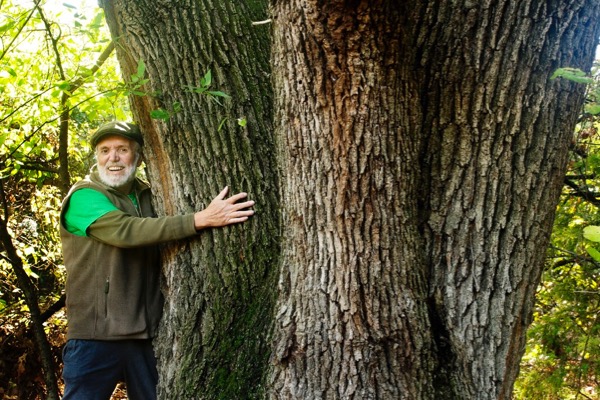 Jim Frisinger hugs the Old Caddo Oak at the Southwest Nature Preserve in Arlington. It was designated as a historic tree by the Texas Historic Tree Coalition in 2019. Photo by J.G. Domke.
Jim Frisinger hugs the Old Caddo Oak at the Southwest Nature Preserve in Arlington. It was designated as a historic tree by the Texas Historic Tree Coalition in 2019. Photo by J.G. Domke.
According to Texas Historic Tree Coalition, a historic tree is a tree (or group of trees) that are at least 50 years old and share a significant event in a specific place in time. A heritage tree has deep significance to a community. It may have been planted in honor of someone or a group of people that are significant to the community, such as trees planted for a memorial.
So far Texas Historic Tree Coalition has recognized about 30 trees across Texas, including more than a dozen in the DFW area.
“We’d like to have a historic tree in every county in the state,” Houser said.
They’ve also partnered with the Texas A&M Forest Service, Trinity Blackland Urban Forestry Council and the Cross Timbers Urban Forestry Council to create the Texas Trees Trail, which features maps of special trees. These include Champion Trees listed on the Texas Big Tree Registry, which recognizes the largest known examples of a tree species, growing in the state. Anyone can nominate a tree for the Big Tree Registry. The trees can be located on private or public property.
Houser said singling out trees is the best way to save them.
“We cannot preserve what we fail to recognize is significant and important,” he said.
Meanwhile, the city of Fort Worth started its own proactive approach to conservation with the Open Space Conservation Program. The program. launched last year, aims to identify and preserve high priority natural areas to provide environmental benefits and recreational opportunities for residents.
According to Jennifer Dyke, head of the interdepartmental team that oversees the Open Acquisitions Program, the city of Fort Worth is growing by around 20,000 people a year. That means a lot of land is being plowed under.
“We estimate that around 50 acres a week of undeveloped land is lost for new development,” said Dyke told Green Source DFW, last year. ”That's a pre-COVID number.”
While the program leaders can’t force property owners to conserve natural areas on their properties or prohibit development, they aim to partner with landowners to encourage voluntary conservation of natural areas.
FENDING OFF CLIMATE CHANGE
Mary Graves, president of the Texas Historic Tree Coalition, says as cities face the consequences of climate change, they aren't putting enough value on the very things can would help combat it - large, mature trees.
“Smaller trees don’t come close to providing the environmental benefits of a big tree,” she said.
“One large tree of about 20-inches in diameter does the work of approximately 40 two-inch diameter trees.”
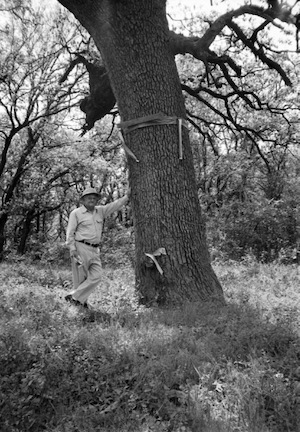 Bill Bardin with the Witness Oak in south Arlington in 1986. The post oak was estimated to be at least 200 years old when it died in 1992 after being moved by developers of a Kmart. Courtesy, Special Collections, UT Arlington Libraries.
Bill Bardin with the Witness Oak in south Arlington in 1986. The post oak was estimated to be at least 200 years old when it died in 1992 after being moved by developers of a Kmart. Courtesy, Special Collections, UT Arlington Libraries.
She said big trees are disappearing fast, and they take decades to replace.
“In addition to the beauty of big trees and the value they add to our properties, they go a long way to mitigate the urban heat island effect, which is a major factor in North Texas.”
Grace Darling, longtime member of the Arlington Conservation Council, lobbied for saving a stand of trees in Arlington last year from a townhome development.
Darling said the Arlington tree ordinance is too weak and attempts to update it have been lackluster.
She goes one step further than Graves, saying tree ordinances should start with the principle that all trees are worth retaining. They provide important ecological functions that benefit human health and the environment.
“We must start from scratch with a real tree preservation scheme - no mitigation - that reflects the true cost to society of removing trees over each tree's lifespan,” Darling said. “We need to act now for future generations or there won't be anything worth saving before long.”
RELATED ARTICLES
Arlington couple helped turn former nursery into nature park
Tree advocates want stricter tree ordinance in Arlington
Centuries-old tree dedicated at Arlington preserve
Arlington creek project will sacrifice mature trees, homeowner says
New Dallas tree zoning law to be voted on Wednesday
Texas legislators raise an axe against local tree ordinances
Abbott’s attempt to thwart local control over tree ordinances 'stumps' voters
Landmark tree defended from vandal by Dallas neighbors
Comanche marker trees in Texas chronicled by Dallas tree expert
Arlington group searching for pecan trees developed by O.S. Gray Nursery
Dallas-based group searching for historic trees across Texas
Stay up to date on everything green in North Texas, including the latest news and events! Sign up for the weekly Green Source DFW Newsletter! Follow us on Facebook and Twitter. Also check out our new podcast The Texas Green Report, available on your favorite podcast app.









